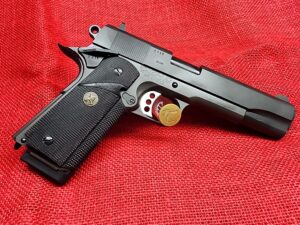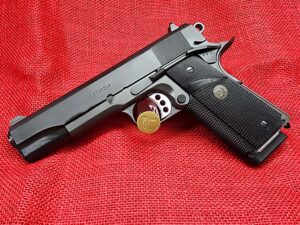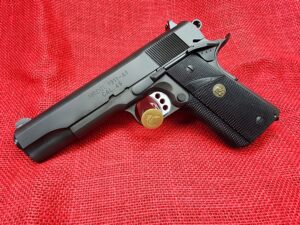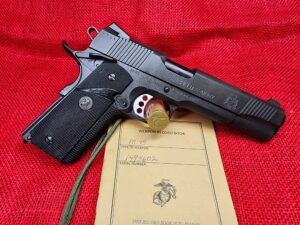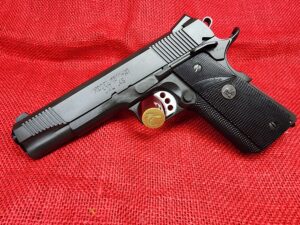MEU (SOC) Variations
All of the MEUSOC pistols produced by the RTE & PWS shops used USGI M1911A1 receivers almost exclusively. There were some of the later generation of pistols that did use Caspian Arms Ltd. receivers due to a shortage of useable GI receivers. There was a specific serial number sequence on those receivers. The rest of this information is a collection of my memory, research and conversation with current and former 2112’s in my attempt to completely document, as accurately as possible, the history of the MEU (SOC) M1911A1 .45 cal. pistol. Specifically, I would like to thank Mr. Shawn Schumacher for his valuable assistance and information in keeping the identification and history of the USMC MEU (SOC) pistol as accurate as possible.
Generation / Variant 1
System “hard” slide with standard sight cuts. Many of these slides were the 7 digit 7790314 slides. I believe that a few of the Drake NM7791435 slides were also used. The front sight was a Millett stake on front using the existing tenon sight cut. Problems were identified early on with the staked front sights shooting loose very quickly. Millett had introduced a new product call the “dual crimp” front sight. These sights were introduced to the build process in hopes of keeping the front sight tight and secure to the slide. This process also failed and front sights were silver soldered to ensure complete retention and not shooting loose during the life cycle of the pistol. The rear sight was manufactured by the RTE shop and also used the existing dovetail. A Bar-Sto “semi-fit” barrel and bushing were used exclusively at this time. The receiver was modified for a Clark 180 / Wilson 66 beavertail grip safety. A Kings 201-A ambidextrous was used in place of the standard GI thumb safety. MGW (Maryland Gun Works) commander hammer and hard sear were used to provide a long lasting trigger pull. A standard GI arched mainspring was cut down to a flat configuration and serrated at 20 LPI retaining the lanyard loop. A Videcki solid stainless steel trigger with the over-travel screw hole welded up was to ensure 100% reliability. Pachmayr Gripper grips were fit to the pistol along with Wilson 47 magazines. Also Wilson shok-buffs were issued with the pistol and the 2112 that built the gun made all the annotations in the gun book to document the history, maintenance and round count on the pistol.
Generation / Variant 2
These pistols were the start of the rebuild process as guns came back to the shop after a deployment / rotation with the using units. A complete inspection was conducted and any maintenance required was of course performed. The pistol remained basically identical to the Gen 1 configuration with the exception of a Videcki 3-hole speed trigger and the Springfield Armory slides being introduced as replacement. The RTE manufactured rear sight and silver soldered Millett front sight were retained. These slides had a variety of markings because of availability at the time of need. The first slides had only vertical rear cocking serrations, Springfield Armory on the right side of the slide and no crossed cannons. The left side of the slide was marked MODEL 1911-A1. Other slides had forward slanted, rear only cocking serrations. Crossed cannons to the rear of the ejection port and Springfield Armory on the right side. The left side was marked MODEL 1911-A1 and centered below that CAL .45.
Generation / Variant 3
Bottom end of pistol still identical to Generation 1. Now the slide is Springfield Armory with crossed cannons on the right side of the ejection port. And MODEL 1911-A1 and CAL .45 on the left with the RTE rear sight and the Millett silver soldered front. In late 2002 early 2003 we started to Magnaflux all receivers and any that came back from the fleet were coded out, all the ones built from that point on had the Ed Brown grip safety. This is not to say that the slide may have been replaced out in the fleet. Parts availability for units both deployed and stateside could be difficult. The local 2112 did what was necessary to keep the pistol up and running. That could mean open purchase of parts that were not available in the supply system. Additional information added by Mr. Schumacher as he was in the PWS shop at the time of production. At the same point that we started to use the Ed Brown Grip safety (2002 2003) was also the time that the new Springfield slides with Novak sight cut were put into service which was to the best of my memory late 2002. I do not recall if any that had the Ed Brown grip safety/new Springfield slide were built using the MGW hammer & sear. If these parts changes didn’t happen all at the same time it happened very close together. In 2001/2002 they tried to do a product improvement on the pistol, they wanted to add the 1913 rail to the dust cover, the Novak sights, C&S ignition system along with a few other parts one being the grip safety. The program failed terribly, the frames cracked at the junction of the rails and dust cover. That is why the shop started to Magnaflux the receiver, we had about a 50% failure rate. In the first 100 receivers inspected 48 had cracks already. This is what prompted the use of the Caspian frames. Someone at SysCom had already purchased 600 of the new Springfield slides, Ed Brown grip safeties and some other parts, so at that point they made the decision to go ahead and use the parts. Shortly after that decision was made I went to Maj Manning (the project officer at SysCom) and ask if we could go ahead and change the ignition parts to C&S seem that was the direction they planned to go and that was one of the biggest complaint about the pistol. So with all that being said I would guess that this would have been the start of Gen 4.
Generation / Variant 4
This is the biggest change to the pistol since the introduction back in the late 80’s. The slide is the new Springfield Armory with the Novak low mount sight cut in the rear and a dovetail front. Flat forward slanted cocking serrations front and rear. Lowered and flared ejection port. Black on black Novak sight set. Markings on the slide remain the same as the gen 3. The lower receiver gets a major update. At the start of this variation the King Thumb safety was still being used, production of this variation began in early 2003. Also there was a very small amount of these that had been built with Wilson drop in barrels (it would not have been more than 50 and only during the 2003 production) all others would have had the Bar-Sto semi-drop in barrel. I also found some examples with a Nowlin barrel that came in for maintenance. Additional information added by Mr. Schumacher as he was in the PWS shop at the time of production. Nowlin was the barrel that they had chosen to use when they started the product improvement, but I don’t recall them ever being used in production and as you said they used what they could get the very reason that some went out with Wilson barrels. Again there were times that you had to use what you could get to keep the pistols running. This variation was built until about Apr-Mar of 2007 when they switched it to the Ed Brown thumb safety. There were a few of the variations using the King safety that had been built with Caspian receivers and towards the end of production of the ones with the Ed Brown safety. There was also a small number of both variations that were built using Caspian slides (maybe around 100 total). The Caspian slides had Novak sight cuts, front and rear flat slated serrations, a Marine Corps emblem on both sides behind the rear serrations and USMC on the ejection port side. In mid-2004 they switched to a Caspian flat serrated mainspring housing. At some point an order of Springfield slide came in that were marked OPERATOR, CAL .45 on the non-ejection port side (I don’t know how many got built using these slide). They also switched from the GM-45C Pachmayr to the GM-45 towards the end of this variation (earlier versions of both grips had to be modified for the Ed Brown thumb safety). Cylinder & Slide fire control components replaced the MGW set w
ith a new hammer, sear and disconnector. Night sights were never “officially” authorized for the pistol but many of them came in for maintenance with night sights because of operator / mission preferences.
USMC 1911 MEU(SOC) Pistol
There were 4 generations / variants of the MEU(SOC) pistol. I have done extensive research and with the assistance of former 12’s been able to document the best known list of features and parts used in each different model. Pricing is as follows:
GENERATION 1
Built on YOUR GI receiver I will provide and fit the following parts. System hard slide with silver soldered Millett front sight and a new manufactured exact copy of the RTE designed rear sight. Bar-Sto barrel and bushing. New manufactured Wilson 66 beavertail grip safety. Kings 201-A new manufactured ambidextrous thumb safety. New manufactured MGW style commander hammer, sear and disconnector. Greider 3-hole speed trigger. Pachmayr grips, with 7 Wilson 47 magazines. Complete build with a manganese phosphate finish. An exact copy reproduction gun book will be included and filled out with all appropriate information about the build.
Cost $3300.00 plus tax and shipping. Once you approve your estimate that places you in the work queue.
I can provide a Springfield Armory GI receiver for an additional $450.00
GENERATION 2
Exact copy of Generation 1 but built with a Springfield Armory slide in place of the system hard slide.
Cost $3500.00 plus tax and shipping. Once you approve your estimate that places you in the work queue.
I can provide a Springfield Armory GI receiver for an additional $450.00
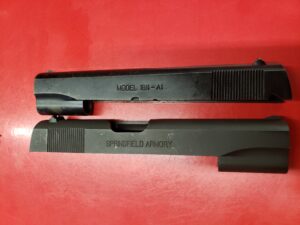

Early Generation 2 slide above Late Generation 2 slide above
GENERATION 3
Exact copy of Generation 2 with a new manufactured Wilson 66 beavertail grip safetyEd or the Brown bar stock memory groove beavertail grip safety. There is an additional charge of $200.00 to weld up the receiver to properly fit the Ed Brown memory groove beavertail.
Cost $3500.00 plus tax and shipping for the Wilson 66 beavertail.
Cost $3700.00 plus tax and shipping for the Ed Brown memory groove beavertail. Once you approve your estimate that places you in the work queue.
I can provide a Springfield Armory GI receiver for an additional $450.00
GENERATION 4
Exact copy of Generation 3 with the latest Springfield Armory slide with Novak sight cuts front and rear with sights. An Ed Brown bar stock memory groove beavertail, ambidextrous thumb safety and the Cylinder and Slide fire control set.
Cost $4000.00 plus tax and shipping. Once you approve your estimate that places you in the work queue.
I can provide a Springfield Armory GI receiver for an additional $450.00
Gen 4
